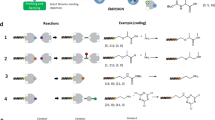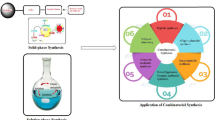Summary
With the advent of combinatorial chemistry a new paradigm is evolving in the field of drug discovery. The approach is based on an integration of chemistry, high-throughput screening and automation engineering. The chemistry arm is usually based on solid-phase synthesis technology as the preferred approach to library construction. One of the most powerful of the solid-phase methods is encoded split synthesis, in which the reaction history experience by each polymeric bead is unambiguously recorded. This split-and-pool approach, employing chemically robust tags, was used to construct a 85 000-membered dihydrobenzopyran library.
Similar content being viewed by others
References
Gordon, E.M., Barrett, R.W., Dower, W.J., Fodor, S.P.A and Gallop, M.,Applications of combinatorial technologies to drug discovery. 2. Combinatorial organic synthesis, library screening strategies, and future directions, J. Med. Chem., 37 (1994) 1385–1401.
Geysen, M.H., Meloen, R.H. and Barteling, S.J.,Use of peptide synthesis to probe viral antigens for epitopes to a resolution of a single amino acid, Proc. Natl. Acad. Sci. USA, 81 (1984) 3998–4002.
Houghten, R.A.,General method for the rapid solid-phase synthesis of large numbers of peptides: Specificity of antigen-antibody interaction at the level of individual amino acids, Proc. Natl. Acad. Sci. USA, 82 (1985) 5131–5135.
DeWitt, S.H., Kiely, J.S., Stankovic, C.J., Schroeder, M.C., Reynolds-Cody, D.M. and Pavia, M.R.,‘Diversomers’: An approach to nonpeptide, nonoligomeric chemical diversity, Proc. Natl. Acad. Sci. USA, 90 (1993) 6909–6913.
Schnorrenberg, G. and Gerhardt, H.,Fully automatic simultaneous multiple peptide synthesis in micromolar scale —Rapid synthesis of series of peptides for screening in biological assays, Tetrahedron, 45 (1989) 7759–7764.
Gausepohl, H., Bovlin, C., Kraft, M. and Frank, R.W.,Automated multiple peptide synthesis, Pept. Res., 5 (1992) 315–320.
Zuckermann, R.N. and Banville, S.C.,Automated peptide-resin deprotection — Cleavage by a robotic workstation, Pept. Res., 5 (1992) 169–174.
Read, J.L., Pirrung, M.C., Stryer, L., Lu, L.A.T. and Solas, D.,Light-directed, spatially addressable parallel chemical synthesis, Science, 251 (1991) 767–773.
Furka, A., Sebestyen, F., Asgedom, M. and Dibo, G.,General method for rapid synthesis of mullicomponent peptide mixtures, Int. J. Pept. Protein Res., 37 (1991) 487–493.
Lam, K.S., Salmon, S.E., Hersh, E.M., Hruby, V.J., Kazmierski, W.M. and Knapp, R.J.,A new type of synthetic peptide library for identifying ligand-binding activity, Nature, 354 (1991) 82–86.
Houghten, R.A., Pinilla, C., Blondell, S.E., Appel, J.R., Dooley, C.T. and Cuervo, J.H.,Generation and use of synthetic peptide combinatorial libraries for basic research and drug discovery, Nature, 354 (1991) 84–86.
Burgess, K., Lien, A.I. and Wang, N.,Combinatorial technologies involving reiterative division/coupling/recombination: Statistical considerations, J. Med. Chem., 37 (1994) 2985–2987.
Brummel, C.L., Lee, I.N.W., Zhou, Y. and Benkovic, S.J.,A mass spectrometric solution to the address problem of combinatorial libraries, Science, 264 (1994) 399–402.
Metzger, J.W., Kempter, C., Wiesmuller, K.N. and Jung, G.,Electrospray mass spectrometry and tandem mass spectrometry of synthetic multicomponent peptide mixtures: Determination of composition and purity, Anal. Biochem., 219 (1994) 261–277.
Egner, B.J., Langley, G.J. and Bradley, M.,Solid-phase chemistry: Direct monitoring by matrix-assisted laser desorption/ionization time-of-flight mass spectrometry. A tool for combinatorial chemistry, J. Org. Chem., 60 (1995) 2652–2653.
Brenner, S. and Lerner, R.A.,Encoded combinatorial chemistry, Proc. Natl. Acad. Sci. USA, 89 (1992) 5381–5383.
Nielsen, J., Brenner, S. and Janda, K.D.,Synthetic methods for the implementation of encoded combinatorial chemistry, J. Am. Chem. Soc., 115 (1993) 9812–9813.
Needels, M.N., Jones, D.G., Tate, E.N., Heinkel, G.L., Koehersperger, L.M., Dower, W.J., Barrett, R.W. and Gallop, M.A.,Generation and screening of an oligonucleotide-encoded synthetic peptide library, Proc. Natl. Acad. Sci. USA, 90 (1993) 10700–10704.
Kerr, J.M., Banville, S.C. and Zuckermann, R.N.,Encoded combinatorial peptide libraries containing nonnatural amino acids, J. Am. Chem. Soc., 115 (1993) 2529–2531.
Nikolaiev, V., Stierandova, A., Krchñák, V., Seligmann, B., Lam, K.E., Salmon, S.E. and Lebl, M.,Peptide-encoding for structure determination of nonsequenceable polymers within libraries synthesized and tested on solid-phase supports, Pept. Res., 6 (1993) 161–170.
Lebl, M., Krchñák, V., Sepetov, N.F., Seligmann, B., Strop, P., Felder, S. and Lam, K.S.,One-bead-one-structure combinatorial libraries, Biopolymers (Pept. Sci.), 37 (1995) 177–198.
Ohlmeyer, M.H.J., Swanson, R.N., Dillard, L.W., Reader, J.C., Asouline, G., Kobayashi, R., Wigler, M. and Still, W.C.,Complex synthetic chemical libraries indexed with molecular tags, Proc. Natl. Acad. Sci. USA, 90 (1993) 10922–10926.
Nestler, H.P., Bartlett, P.A. and Still, W.C.,A general method for molecular tagging of encoded combinatorial chemistry libraries, J. Org. Chem., 59 (1994) 4723–4724.
Hill, H.H. and McMinn, D.G. (Eds.) Detectors for Capillary Chromatography, Chemical Analysis, Vol. 121, Wiley, New York, NY, U.S.A., 1992, pp. 83–107.
Baldwin, J.J., Burbaum, J.J., Henderson, I. and Ohlmeyer, M.H.J.,Synthesis of a small-molecule combinatorial library encoded with molecular tags, J. Am. Chem. Soc., 117 (1995) 5588–5589.
Burbaum, J.J., Ohlmeyer, M.H.J., Reader, J.C., Henderson, I., Dillard, L.W., Li, G., Randle, T.L., Sigal, N.N., Chelsky, D. and Baldwin, J.J.,A paradigm for drug discovery employing encoded combinatorial libraries, Proc. Natl. Acad. Sci. USA, 92 (1995) 6027–6031.
Author information
Authors and Affiliations
Rights and permissions
About this article
Cite this article
Baldwin, J.J. Design, synthesis and use of binary encoded synthetic chemical libraries. Mol Divers 2, 81–88 (1996). https://doi.org/10.1007/BF01718704
Received:
Accepted:
Issue Date:
DOI: https://doi.org/10.1007/BF01718704




